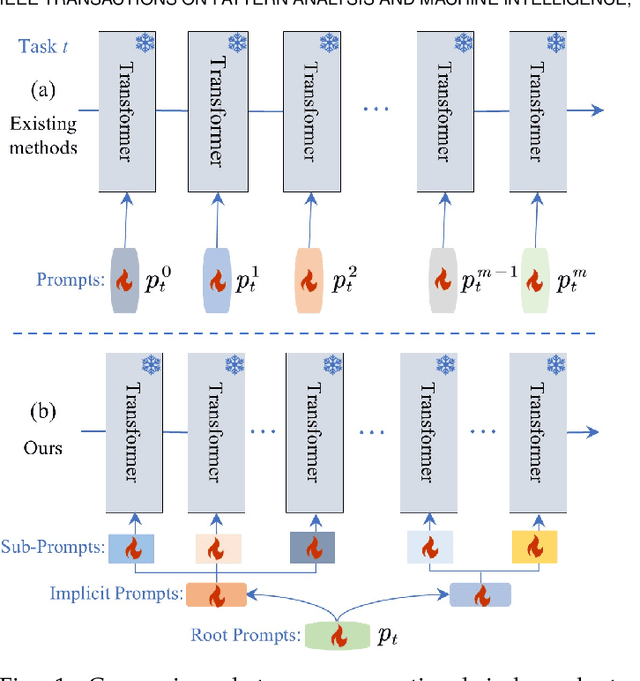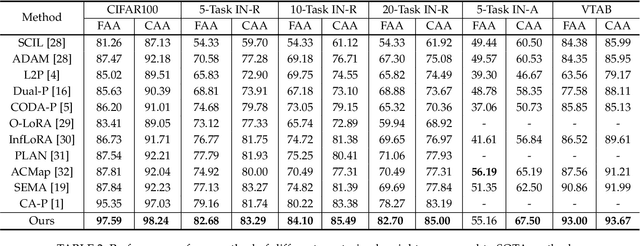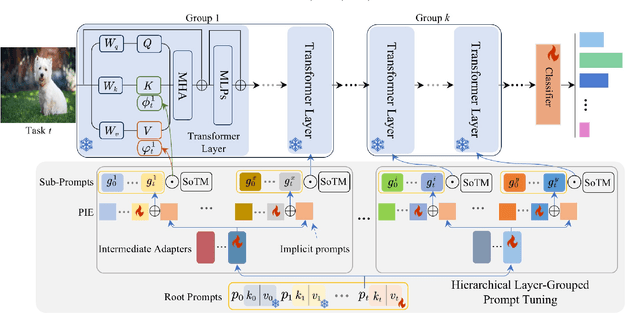Ming-Hsuan Yang
Edit3r: Instant 3D Scene Editing from Sparse Unposed Images
Dec 31, 2025Abstract:We present Edit3r, a feed-forward framework that reconstructs and edits 3D scenes in a single pass from unposed, view-inconsistent, instruction-edited images. Unlike prior methods requiring per-scene optimization, Edit3r directly predicts instruction-aligned 3D edits, enabling fast and photorealistic rendering without optimization or pose estimation. A key challenge in training such a model lies in the absence of multi-view consistent edited images for supervision. We address this with (i) a SAM2-based recoloring strategy that generates reliable, cross-view-consistent supervision, and (ii) an asymmetric input strategy that pairs a recolored reference view with raw auxiliary views, encouraging the network to fuse and align disparate observations. At inference, our model effectively handles images edited by 2D methods such as InstructPix2Pix, despite not being exposed to such edits during training. For large-scale quantitative evaluation, we introduce DL3DV-Edit-Bench, a benchmark built on the DL3DV test split, featuring 20 diverse scenes, 4 edit types and 100 edits in total. Comprehensive quantitative and qualitative results show that Edit3r achieves superior semantic alignment and enhanced 3D consistency compared to recent baselines, while operating at significantly higher inference speed, making it promising for real-time 3D editing applications.
KnowVal: A Knowledge-Augmented and Value-Guided Autonomous Driving System
Dec 23, 2025Abstract:Visual-language reasoning, driving knowledge, and value alignment are essential for advanced autonomous driving systems. However, existing approaches largely rely on data-driven learning, making it difficult to capture the complex logic underlying decision-making through imitation or limited reinforcement rewards. To address this, we propose KnowVal, a new autonomous driving system that enables visual-language reasoning through the synergistic integration of open-world perception and knowledge retrieval. Specifically, we construct a comprehensive driving knowledge graph that encodes traffic laws, defensive driving principles, and ethical norms, complemented by an efficient LLM-based retrieval mechanism tailored for driving scenarios. Furthermore, we develop a human-preference dataset and train a Value Model to guide interpretable, value-aligned trajectory assessment. Experimental results show that our method substantially improves planning performance while remaining compatible with existing architectures. Notably, KnowVal achieves the lowest collision rate on nuScenes and state-of-the-art results on Bench2Drive.
Depth Any Panoramas: A Foundation Model for Panoramic Depth Estimation
Dec 18, 2025



Abstract:In this work, we present a panoramic metric depth foundation model that generalizes across diverse scene distances. We explore a data-in-the-loop paradigm from the view of both data construction and framework design. We collect a large-scale dataset by combining public datasets, high-quality synthetic data from our UE5 simulator and text-to-image models, and real panoramic images from the web. To reduce domain gaps between indoor/outdoor and synthetic/real data, we introduce a three-stage pseudo-label curation pipeline to generate reliable ground truth for unlabeled images. For the model, we adopt DINOv3-Large as the backbone for its strong pre-trained generalization, and introduce a plug-and-play range mask head, sharpness-centric optimization, and geometry-centric optimization to improve robustness to varying distances and enforce geometric consistency across views. Experiments on multiple benchmarks (e.g., Stanford2D3D, Matterport3D, and Deep360) demonstrate strong performance and zero-shot generalization, with particularly robust and stable metric predictions in diverse real-world scenes. The project page can be found at: \href{https://insta360-research-team.github.io/DAP_website/} {https://insta360-research-team.github.io/DAP\_website/}
Image Diffusion Preview with Consistency Solver
Dec 15, 2025Abstract:The slow inference process of image diffusion models significantly degrades interactive user experiences. To address this, we introduce Diffusion Preview, a novel paradigm employing rapid, low-step sampling to generate preliminary outputs for user evaluation, deferring full-step refinement until the preview is deemed satisfactory. Existing acceleration methods, including training-free solvers and post-training distillation, struggle to deliver high-quality previews or ensure consistency between previews and final outputs. We propose ConsistencySolver derived from general linear multistep methods, a lightweight, trainable high-order solver optimized via Reinforcement Learning, that enhances preview quality and consistency. Experimental results demonstrate that ConsistencySolver significantly improves generation quality and consistency in low-step scenarios, making it ideal for efficient preview-and-refine workflows. Notably, it achieves FID scores on-par with Multistep DPM-Solver using 47% fewer steps, while outperforming distillation baselines. Furthermore, user studies indicate our approach reduces overall user interaction time by nearly 50% while maintaining generation quality. Code is available at https://github.com/G-U-N/consolver.
Teaching Prompts to Coordinate: Hierarchical Layer-Grouped Prompt Tuning for Continual Learning
Nov 15, 2025



Abstract:Prompt-based continual learning methods fine-tune only a small set of additional learnable parameters while keeping the pre-trained model's parameters frozen. It enables efficient adaptation to new tasks while mitigating the risk of catastrophic forgetting. These methods typically attach one independent task-specific prompt to each layer of pre-trained models to locally modulate its features, ensuring that the layer's representation aligns with the requirements of the new task. However, although introducing learnable prompts independently at each layer provides high flexibility for adapting to new tasks, this overly flexible tuning could make certain layers susceptible to unnecessary updates. As all prompts till the current task are added together as a final prompt for all seen tasks, the model may easily overwrite feature representations essential to previous tasks, which increases the risk of catastrophic forgetting. To address this issue, we propose a novel hierarchical layer-grouped prompt tuning method for continual learning. It improves model stability in two ways: (i) Layers in the same group share roughly the same prompts, which are adjusted by position encoding. This helps preserve the intrinsic feature relationships and propagation pathways of the pre-trained model within each group. (ii) It utilizes a single task-specific root prompt to learn to generate sub-prompts for each layer group. In this way, all sub-prompts are conditioned on the same root prompt, enhancing their synergy and reducing independence. Extensive experiments across four benchmarks demonstrate that our method achieves favorable performance compared with several state-of-the-art methods.
PAS: A Training-Free Stabilizer for Temporal Encoding in Video LLMs
Nov 14, 2025Abstract:Video LLMs suffer from temporal inconsistency: small shifts in frame timing can flip attention and suppress relevant frames. We trace this instability to the common extension of Rotary Position Embeddings to video through multimodal RoPE. The induced inverse Fourier time kernel exhibits frame-scale ripples that multiply adjacent frames by different factors, which perturbs attention that should otherwise be governed by the raw query key inner product. We present Phase Aggregated Smoothing (PAS), a simple, training-free mechanism that applies small opposed phase offsets across heads and then aggregates their outputs. PAS preserves the per-head spectrum magnitude, while the aggregation effectively smooths the temporal kernel and reduces phase sensitivity without changing the positional encoding structure. Our analysis shows that the RoPE rotated logit can be approximated as a content dot product scaled by a time kernel; smoothing this kernel yields Lipschitz stability of attention to small temporal shifts; multi phase averaging attenuates high frequency ripples while preserving per-head spectra under Nyquist-valid sampling. Experiments on multiple video understanding benchmarks under matched token budgets show consistent improvements with negligible computational overhead. PAS provides a plug and play upgrade for robust temporal encoding in Video LLMs.
HENet++: Hybrid Encoding and Multi-task Learning for 3D Perception and End-to-end Autonomous Driving
Nov 10, 2025Abstract:Three-dimensional feature extraction is a critical component of autonomous driving systems, where perception tasks such as 3D object detection, bird's-eye-view (BEV) semantic segmentation, and occupancy prediction serve as important constraints on 3D features. While large image encoders, high-resolution images, and long-term temporal inputs can significantly enhance feature quality and deliver remarkable performance gains, these techniques are often incompatible in both training and inference due to computational resource constraints. Moreover, different tasks favor distinct feature representations, making it difficult for a single model to perform end-to-end inference across multiple tasks while maintaining accuracy comparable to that of single-task models. To alleviate these issues, we present the HENet and HENet++ framework for multi-task 3D perception and end-to-end autonomous driving. Specifically, we propose a hybrid image encoding network that uses a large image encoder for short-term frames and a small one for long-term frames. Furthermore, our framework simultaneously extracts both dense and sparse features, providing more suitable representations for different tasks, reducing cumulative errors, and delivering more comprehensive information to the planning module. The proposed architecture maintains compatibility with various existing 3D feature extraction methods and supports multimodal inputs. HENet++ achieves state-of-the-art end-to-end multi-task 3D perception results on the nuScenes benchmark, while also attaining the lowest collision rate on the nuScenes end-to-end autonomous driving benchmark.
From Masks to Worlds: A Hitchhiker's Guide to World Models
Oct 23, 2025Abstract:This is not a typical survey of world models; it is a guide for those who want to build worlds. We do not aim to catalog every paper that has ever mentioned a ``world model". Instead, we follow one clear road: from early masked models that unified representation learning across modalities, to unified architectures that share a single paradigm, then to interactive generative models that close the action-perception loop, and finally to memory-augmented systems that sustain consistent worlds over time. We bypass loosely related branches to focus on the core: the generative heart, the interactive loop, and the memory system. We show that this is the most promising path towards true world models.
One Flight Over the Gap: A Survey from Perspective to Panoramic Vision
Sep 04, 2025



Abstract:Driven by the demand for spatial intelligence and holistic scene perception, omnidirectional images (ODIs), which provide a complete 360\textdegree{} field of view, are receiving growing attention across diverse applications such as virtual reality, autonomous driving, and embodied robotics. Despite their unique characteristics, ODIs exhibit remarkable differences from perspective images in geometric projection, spatial distribution, and boundary continuity, making it challenging for direct domain adaption from perspective methods. This survey reviews recent panoramic vision techniques with a particular emphasis on the perspective-to-panorama adaptation. We first revisit the panoramic imaging pipeline and projection methods to build the prior knowledge required for analyzing the structural disparities. Then, we summarize three challenges of domain adaptation: severe geometric distortions near the poles, non-uniform sampling in Equirectangular Projection (ERP), and periodic boundary continuity. Building on this, we cover 20+ representative tasks drawn from more than 300 research papers in two dimensions. On one hand, we present a cross-method analysis of representative strategies for addressing panoramic specific challenges across different tasks. On the other hand, we conduct a cross-task comparison and classify panoramic vision into four major categories: visual quality enhancement and assessment, visual understanding, multimodal understanding, and visual generation. In addition, we discuss open challenges and future directions in data, models, and applications that will drive the advancement of panoramic vision research. We hope that our work can provide new insight and forward looking perspectives to advance the development of panoramic vision technologies. Our project page is https://insta360-research-team.github.io/Survey-of-Panorama
DrivingGaussian++: Towards Realistic Reconstruction and Editable Simulation for Surrounding Dynamic Driving Scenes
Aug 28, 2025Abstract:We present DrivingGaussian++, an efficient and effective framework for realistic reconstructing and controllable editing of surrounding dynamic autonomous driving scenes. DrivingGaussian++ models the static background using incremental 3D Gaussians and reconstructs moving objects with a composite dynamic Gaussian graph, ensuring accurate positions and occlusions. By integrating a LiDAR prior, it achieves detailed and consistent scene reconstruction, outperforming existing methods in dynamic scene reconstruction and photorealistic surround-view synthesis. DrivingGaussian++ supports training-free controllable editing for dynamic driving scenes, including texture modification, weather simulation, and object manipulation, leveraging multi-view images and depth priors. By integrating large language models (LLMs) and controllable editing, our method can automatically generate dynamic object motion trajectories and enhance their realism during the optimization process. DrivingGaussian++ demonstrates consistent and realistic editing results and generates dynamic multi-view driving scenarios, while significantly enhancing scene diversity. More results and code can be found at the project site: https://xiong-creator.github.io/DrivingGaussian_plus.github.io
 Add to Chrome
Add to Chrome Add to Firefox
Add to Firefox Add to Edge
Add to Edge